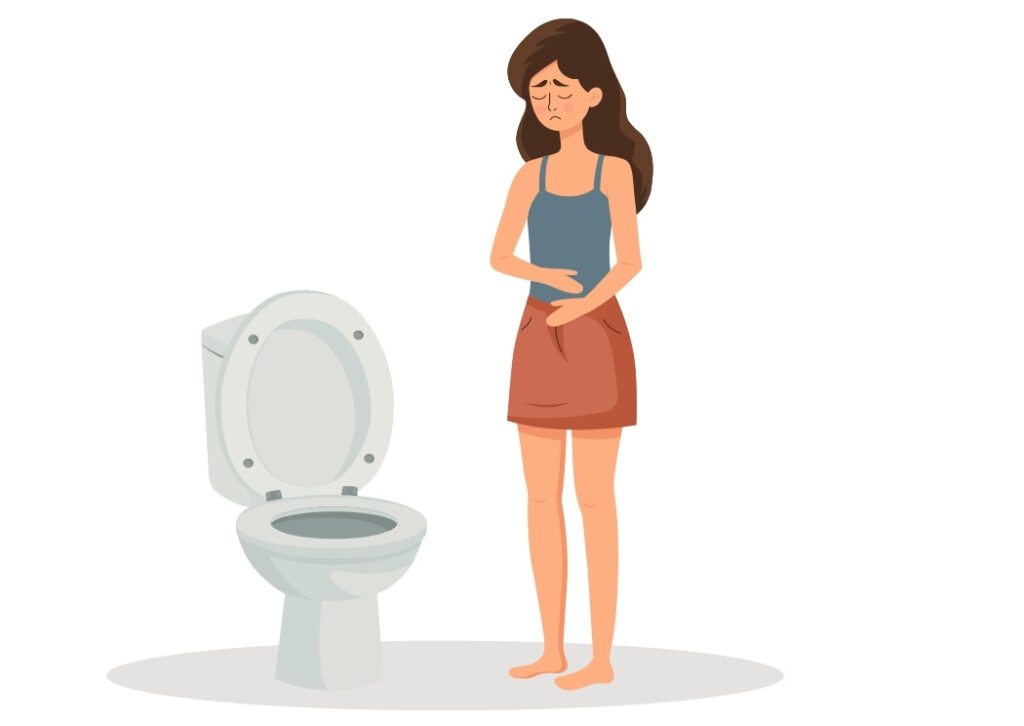It happens to you after lunch, or just at night on the couch: that full, oppressive feeling in your middle. You unzip your pants a hole and wonder where it went wrong. Below, I'll take you step by step. We'll explore exactly what bloating is, what causes often come into play and how to quietly test whether food is having an impact. We also look at what you can do if dairy products turn out to be the culprit.
Notice: This blog is informational and not medical advice. If you have severe or persistent symptoms, or are concerned, contact your doctor. When in doubt, always consult with your doctor or dietitian.
What is bloating
Bloating feels slightly different for everyone. Some describe pressure and tension, others talk about "feeling full quickly" or a stomach that can barely take anything. Sometimes it involves burping or flatulence, sometimes nausea or mild cramps. It's usually harmless and temporary, but cozy is different. Good news: with a few steps and some patience, you often get a quick grip.

This is how you recognize when it starts
Pay attention to timing. Do your symptoms come on soon after a meal, or do they creep in mainly later in the evening? Does it coincide with a cappuccino, a large plate of pasta or a glass of soda? By taking a conscious look for a few days at the moment on which it starts, you often already see a pattern. That pattern is your starting point to explore further.
Common causes, in plain language
There is rarely one offender. Sometimes the pace of eating is: bite, bite, done. You swallow air, your stomach gets little time, and your digestion lags. Other times it's the composition of your plate. Fat and spicy like to linger for a while, as does a large portion right before you go to sleep. Prickly drinks and gum bring in extra air.
And then there are your intestines, which react more sensitively in some people. With PDS, gas formation from relatively innocuous foods can be enough for tummy trouble. Stress also plays a role; your body digests differently when your head is in fifth gear.

And yes, dairy products may have a role, both through lactose and milk proteins. I'll come back to that in a moment.
It is important to know alarm signals. Consider unexplained weight loss, blood in the stool, fever or nighttime pain. If you recognize any of these or are concerned, contact your doctor. Better too early than too late.
Fatigue and bloating
Fatigue and bloating often go hand in hand. Sleeping poorly due to discomfort causes less energy during the day, and messy digestion costs your body just a little extra fuel. Try eating light for a few evenings and see what that does.
A quiet pasta salad, soup with bread, or rice with vegetables and a mild sauce; it's not about perfection, it's about rest. A short walk after dinner often helps more than you think. You literally set your digestion in motion.
Stomach bloating
Is the feeling especially high, as if the stomach takes the lead role? Then it pays to watch fat, acid and pungency for a week. Not because you have to cut everything out, but to see what for you difference. Choose smaller portions, chew a little longer, and give your stomach time. Many people find that one simple swap already helps, such as water or tea instead of soda at dinner.

Bloating and nausea
Nausea can disrupt your whole plan. Go for gentleness. Warm water or tea often works nicely, as does sitting up straight and taking a short walk. If nausea keeps coming back or is severe, consult with your doctor. Especially if vomiting or a fever are involved, you don't want to figure it out yourself.
Abdominal pain and bloating
Abdominal pain associated with bloating often comes from gas and stretching of the intestines. It sounds harmless, but feels anything but pleasant. The pain often subsides when you address triggers. If it still swells with other symptoms such as fever, blood or nighttime pain, medical advice is wise.
Quietly testing whether nutrition factors in
You don't have to change your entire diet to become wiser. Start by observing for three to seven days. Write down what you eat and drink, as well as when the bloating starts. During that same period, try a few simple changes: water or tea instead of soda, no gum for a while, and slightly smaller portions. Most people then already notice a difference in intensity or timing.
Then you choose one targeted test. Suppose you want to examine dairy products. Do so quietly and consistently for two weeks. Replace milk, yogurt, cottage cheese and cream with lactose-free varieties or with plant-based alternatives.

Don't put too many next to it at once or you will lose track. Record daily, briefly and honestly. After two weeks, reintroduce one product in small portions. That moment is worth its weight in gold; you immediately see what works and what doesn't. for you.
When dairy products come into play
Milk products can cause hassles via two routes. The first is lactose, the milk sugar. Your body has the enzyme lactase needed to digest lactose. If that enzyme does not participate sufficiently, more gas may be produced.
The second route are milk proteins such as casein and whey. Sensitivity to these really requires a different approach than with lactose. With lactose, you can play around with lactose-free dairy, plant-based alternatives or, if necessary, a lactaseenzyme at loose moments. With milk proteins, choose products without milk components and label reading becomes even more important.
If you want this difference clear before you, check out our explanation of the difference between lactose intolerance and cow's milk intolerance. Wondering what lactase exactly, start here: what does lactase. And if you want to spot labels faster, this guide will get you started: ingredient list on milk ingredients.

This is how you read the label in real life
In the store, label reading sometimes feels like a mini-exam. You want to choose something delicious without the hassle, and still be sure there are no dairy ingredients hidden in it. In any case, look beyond just "lactose-free." Also look for words like milk, milk powder, cream, whey, whey powder, milk protein, casein, lactose, lactoserum and cheese powder.
What you can already try today
Keep it small and achievable. At dinner, choose a glass of water or tea instead of soda with bubbles. Eat just a touch more leisurely. Split a large meal into two smaller ones. Go outside for ten minutes after eating. And if you want to test dairy, make it simple for two weeks.
It doesn't have to be boring. A plant-based yogurt with fruit, a lactose-free cappuccino, or your favorite dish with a plant-based cooking cream. It's about what you notice, not the perfect score list.
FAQ
What are known causes of bloating?
Often it's a mix. Fast or lots of food, fatty or spicy foods, sodas with bubbles and gum bring on extra air. A sensitive stomach or intestines can react more quickly, as can stress. And in some people, dairy products come into play, via lactose or milk proteins. In addition to bloating, if you get alarm signals such as unexplained weight loss, blood in the stool, fever or nighttime pain, contact your doctor.
How do I test if my bloating is due to food?
Start observing. For three to seven days, write down what you eat and drink and when the feeling starts. Make small substitutions such as water instead of soda and no gum for a while. If you want to test dairy, do so quietly and consistently for two weeks. Then reintroduce in small steps. That way you'll see what really makes a difference.
What is the difference between lactose and milk protein for bloating?
Lactose is milk sugar and for that you have lactase needed. Milk proteins involve proteins such as casein and whey. So the approach differs. With lactose, you can choose lactose-free dairy or an enzyme at odd times. With milk proteins, you choose products without milk components and the label is your best friend. Lactose vs milk protein.
What labels do I look for on the label if I want to avoid milk?
Look out for milk, milk powder, cream, whey, whey powder, milk protein, casein, lactose, lactoserum and cheese powder. And always check the allergen box for "Contains milk." Reading label for milk ingredients.
When should I go to the doctor with bloating?
In case of severe or persistent symptoms or alarm signals as mentioned above. When in doubt, call your doctor. You don't have to figure this out on your own.
Sources and further reading
If you want to dig deeper, check out Pharmacy.com for complaints and backgrounds, at Home Doctor for upset stomach and PDS, and at the Stomach Liver Bowel Foundation for clear explanations in understandable language. For lactose intolerance, you can find basic information at the Nutrition Center. And on NooMooo, you can read more about the difference between lactose and milk protein, what lactase does and how to labels smart reads.

Your reading tip for now
Blog Lactose
Is ghee lactose-free? Clear explanation
Ghee, often called clarified butter in Dutch and known internationally as clarified butter, has...
Sep
Blog Cow's Milk
How do you test whether or not you can tolerate cow's milk well?
A practical guide with clear steps, hassle-free Tummy ache after milk, restlessness after yogurt or...
Aug
Blog Cow's Milk Lactose
Why your tummy might say 'no' to cow's milk
From lactose to protein and exorphins: this is what cow's milk does to your body Cow's milk. For the...
Aug
Blog Cow's Milk
What is the difference between cow's milk allergy and cow's milk intolerance?
And why it's important to know the difference Avoiding cow's milk is one thing....
Jul
Blog Lactose
What does and how does lactase work?
And why your gut won't be happy if it's missing If you have lactose intolerance (or...
Aug
Blog Cow's Milk Reviews
Cow's milk free shopping at HEMA: this is how you choose for sure
HEMA is the place for that quick errand or a cake for tomorrow. Choosing cow's milk free...
Sep